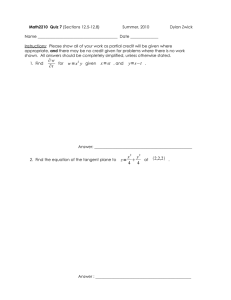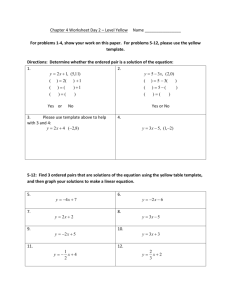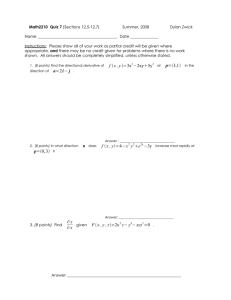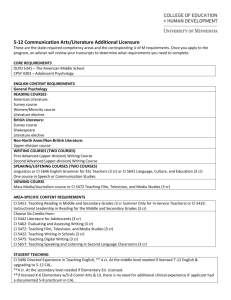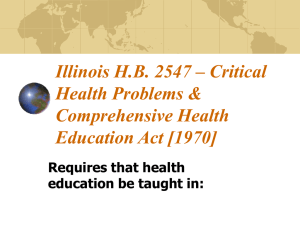Print Report Card SUBMIT REPORTS Contact Us Glossary
advertisement
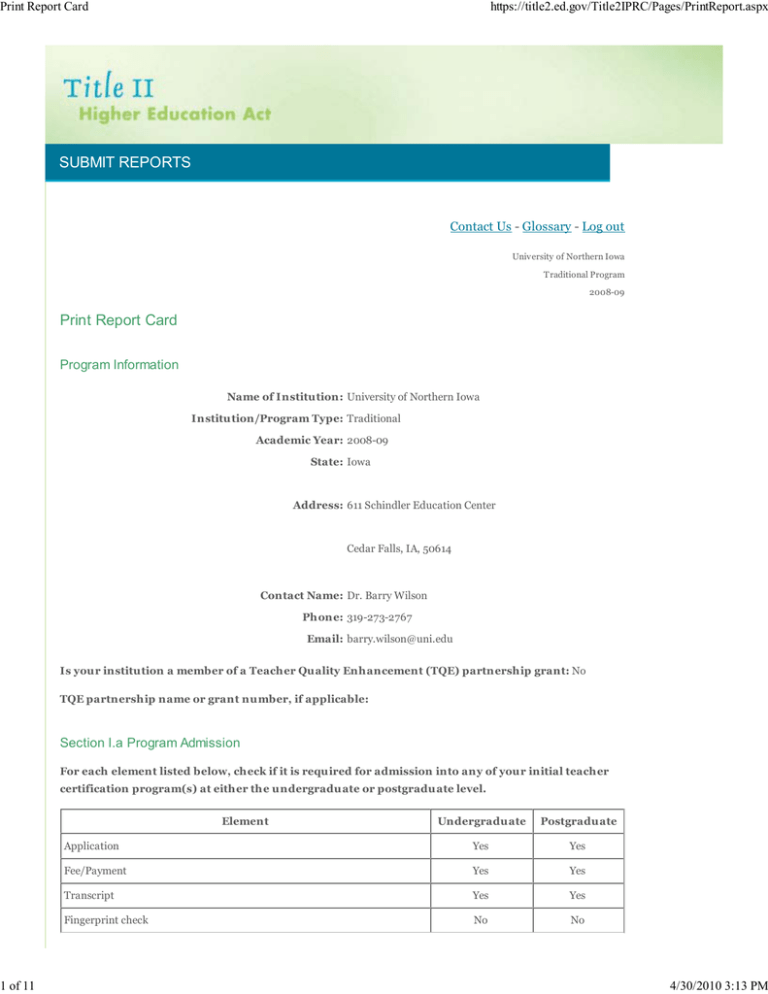
Print Report Card 1 of 11 https://title2.ed.gov/Title2IPRC/Pages/PrintReport.aspx SUBMIT REPORTS Contact Us - Glossary - Log out University of Northern Iowa Traditional Program 2008-09 Print Report Card Program Information Name of Institution: University of Northern Iowa Institution/Program Type: Traditional Academic Year: 2008-09 State: Iowa Address: 611 Schindler Education Center Cedar Falls, IA, 50614 Contact Name: Dr. Barry Wilson Phone: 319-273-2767 Email: barry.wilson@uni.edu Is your institution a member of a Teacher Quality Enhancement (TQE) partnership grant: No TQE partnership name or grant number, if applicable: Section I.a Program Admission For each element listed below, check if it is required for admission into any of your initial teacher certification program(s) at either the undergraduate or postgraduate level. Element Undergraduate Postgraduate Application Yes Yes Fee/Payment Yes Yes Transcript Yes Yes Fingerprint check No No 4/30/2010 3:13 PM Print Report Card 2 of 11 https://title2.ed.gov/Title2IPRC/Pages/PrintReport.aspx Background check No No Experience in a classroom or working with children No No Minimum number of courses/credites/semester hours completed Yes Yes Minimum high school GPA No No Minimum undergraduate GPA Yes Yes Minimum GPA in content area coursework No No Minimum GPA in professional education coursework No No Minimum ACT score No No Minimum SAT score No No Minimum GRE score No No Minimum basic skills test score Yes Yes Subject area/academic content test or other subject matter verification No No Minimum Miller Analogies test score No No Recommendation(s) No No Essay or personal statement Yes Yes Interview No No Resume No No Bechelor's degree or higher No Yes Job offer from school/district No No Personality test (e.g.,Myers-Briggs Assessment) No No Other (specify: OSHA Training ) Yes Yes Provide a link to your website where additional information about admissions requirements can be found: http://www.uni.edu/teached/license/to_do_list.shtml Indicate when students are formally admitted into your initial teacher certification program: Freshman year or transfer Does your initial teacher certification program conditionally admit students? No Please provide any additional about or exceptions to the admissions information provided above: Section I.b Program Enrollment Provide the number of students in the teacher preparation program in the following categories. Note that you must report on the number of students by ethnicity and race separately. Individuals who are non-Hispanic/Latino will be reported in one of the race categories. Also note that individuals can belong to one or more racial groups, so the sum of the members of each racial category may not necessarily add up to the total number of students enrolled. Total number of students enrolled in 2008-09: 2676 4/30/2010 3:13 PM Print Report Card 3 of 11 https://title2.ed.gov/Title2IPRC/Pages/PrintReport.aspx Unduplicated number of males enrolled in 2008-09: 784 Unduplicated number of females enrolled in 2008-09: 1892 2008-09 Number enrolled Ethnicity Hispanic/Latino of any race: 43 Race American Indian or Alaska Native: 5 Asian: 22 Black or African American: 34 Native Hawaiian or Other Pacific Islander: 0 White: 2478 Two or more races: 0 Section I.c Supervised Experience Provide the following information about supervised clinical experience in 2008-09. Average number of clock hours required prior to student teaching 80 Average number of clock hours required for student teaching 640 Number of full-time equivalent faculty in supervised clinical experience during this academic year 18 Number of full-time equivalent adjunct faculty in supervised clinical experience during this academic year (IHE and PreK-12 staff) Number of students in supervised clinical experience during this academic year 7 494 Please provide any additional information about or descriptions of the supervised clinical experiences: Includes student teaching only Section I.d Certified Licensed Provide the number of students who have been certified or licensed as teachers, by subject and area of certification or licensure. Number Teaching subject/area TOTAL (all areas/subjects) 100 - PK-3 Teacher, Reg Educ/Spec Ed 101 - K-12 Athletic Coach Number Number certified/ certified/ certified/ licensed licensed licensed 2008-09 2007-08 2006-07 1048 1119 1140 100 94 134 17 12 21 4/30/2010 3:13 PM Print Report Card 4 of 11 https://title2.ed.gov/Title2IPRC/Pages/PrintReport.aspx 102 - K-6 Teacher Elementary Classroom 269 275 275 104 - K-12 English as a Second Language 7 6 3 108 - K-8 Elementary School Tchr Librarian 12 6 3 109 - 5-12 Secondary School Tchr Librarian 4 2 2 113 - K-8 Art 22 25 24 114 - 5-12 Art 22 23 24 115 - 5-12 Business-General 2 2 5 116 - 5-12 Business-Office 2 2 5 117 - 5-12 Business-Marketing/Management 5 2 5 118 - 5-12 Driver and Safety Education 6 4 14 119 - K-8 english/Language Arts 78 69 79 120 - 5-12 English/Language Arts 19 22 24 124 - 5-12 French 2 6 5 126 - 5-12 German 1 0 1 133 - K-8 Spanish 8 3 4 134 - 5-12 Spanish 9 4 9 138 - 5-12 Health 5 0 2 140 - 5-12 Industrial Technology 8 12 10 142 - K-8 Mathematics 25 32 25 143 - 5-12 Mathematics 16 10 20 144 - K-8 Music 13 13 19 145 - 5-12 Music 13 13 19 146 - K-8 Physical Education 18 15 25 147 - 5-12 Physical Education 18 14 25 148 - K-8 Reading 79 69 77 149 - 5-12 Reading 2 69 6 150 - K-8 Science-Basic 2 3 5 151 - 5-12 Biological Science 5 5 4 152 - 5-12 Chemistry 4 4 2 153 - 5-12 Earth Science 4 11 3 154 - 5-12 General Science 7 8 4 155 - 5-12 Physical Science 6 13 3 156 - 5-12 Physics 3 4 1 186 - 5-12 All Social Sciences 9 11 7 157 - 5-12 American Government 6 6 14 35 39 42 158 - 5-12 American History 4/30/2010 3:13 PM Print Report Card 5 of 11 https://title2.ed.gov/Title2IPRC/Pages/PrintReport.aspx 159 - 5-12 Anthropology 0 2 2 160 - 5-12 Economics 0 0 1 161 - 5-12 Geography 6 5 4 163 - 5-12 Psychology 6 4 11 31 22 12 3 4 6 28 33 28 168 - 5-12 Speech Communications/Theatre 4 5 2 174 - K-12 School Teacher Librarian 5 6 5 49 61 35 0 0 20 33 50 28 2 1 3 262 - PK-K Early Childhood Special Education 9 5 3 264 - K-12 Instructional Strategist II: MD 8 7 10 267 - Birth-21 Visually Impaired 0 4 1 302 - 5-12 Office Education 0 0 1 123 - K-8 French 0 1 0 176 - K-12 Reading Specialist 1 1 0 36 22 3 171 - PK-12 Superintendent & AEA Administrator 4 14 9 172- K-8 Counselor 4 20 10 173 - 5-12 Counselor 4 20 8 0 0 3 234 - 5-12 Work Experience Coordinator 1 4 4 236 - B-21 School Psychologist 6 5 6 16 16 16 239 - Director Special Education 1 0 2 Others (190, 241, 242, 243, 305 0 0 38 36 22 3 164 - K-8 Social Studies 165 - 5-12 Sociology 166 - 5-12 World History 182 - 5-8 Middle School Generalist 189 260 - K-8 Instructional Strategist I: Mild/Moderate 261 - 5-12 Instructional Strategist I: Mild/Moderate 170 - 5-12 Principal 233- K-12 Supervisor Special Education/Instruction 237 - B-21 Speech-Language Pathologist 169- PK-8 Principal Section I.e Program Completers Provide the total number of initial teacher certification preparation program completers in each of the following academic years: 4/30/2010 3:13 PM Print Report Card 6 of 11 https://title2.ed.gov/Title2IPRC/Pages/PrintReport.aspx 2008-09: 442 2007-08: 458 2006-07: 476 Section II. Annual Goals Each institution of higher education (IHE) that conducts a traditional teacher preparation program (including programs that offer any ongoing professional development programs) or alternative routes to state certification or licensure program, and that enrolls students receiving Federal assistance under this Act, shall set annual quantifiable goals for increasing the number of prospective teachers trained in teacher shortage areas designated by the Secretary or by the state educational agency, including mathematics, science, special education, and instruction of limited English proficient students. IHEs that do not have a teacher preparation program in one or more of the areas listed below can enter NA for the area(s) in which the IHE does not have that program. Teacher shortage Goal for increasing prospective teachers trained area Mathematics Academic year: 2008-09 Goal: increase by 3 per year Goal met? No Description of strategies used to achieve goal: 1. Development of a Teacher Intern Alternative Pathway. First students will be admitted Fall 2010. More info at http://www.uni.edu/coe/special-programs/iowa-teacher-internlicense-pathway 2. Participation in the Iowa Mathematics and Science Education Partnership http://www.iowamathscience.org/ Description of steps to improve performance in meeting goal or lessons learned in meeting goal: 1. Setting quantifiable goals 2. Collaborating with partners in K-12 Education, Regents Universities, community colleges, Area Education Agencies, and our Iowa Department of Education Science Academic year: 2008-09 Goal: Increase by 3 per year Goal met? No Description of strategies used to achieve goal: 1. Development of a Teacher Intern Alternative Pathway. First students will be admitted Fall 2010. More info at http://www.uni.edu/coe/special-programs/iowa-teacher-internlicense-pathway 2. Participation in the Iowa Mathematics and Science Education Partnership 4/30/2010 3:13 PM Print Report Card 7 of 11 https://title2.ed.gov/Title2IPRC/Pages/PrintReport.aspx http://www.iowamathscience.org/ Description of steps to improve performance in meeting goal or lessons learned in meeting goal: 1. Setting quantifiable goals 2. Collaborating with partners in K-12 Education, Regents Universities, community colleges, Area Education Agencies, and our Iowa Department of Education Special education Academic year: 2008-09 Goal: Increase by 3 per year Goal met? No Description of strategies used to achieve goal: 1. Development of a Teacher Intern Alternative Pathway. First students will be admitted Fall 2010. More info at http://www.uni.edu/coe/special-programs/iowa-teacher-internlicense-pathway Description of steps to improve performance in meeting goal or lessons learned in meeting goal: 1. Setting quantifiable goals 2. Collaborating with partners in K-12 Education, Regents Universities, community colleges, Area Education Agencies, and our Iowa Department of Education Instruction of limited English proficient students Academic year: 2008-09 Goal: Increase by 3 per year Goal met? No Description of strategies used to achieve goal: 1. Development of a Teacher Intern Alternative Pathway. First students will be admitted Fall 2010. More info at http://www.uni.edu/coe/special-programs/iowa-teacher-internlicense-pathway Description of steps to improve performance in meeting goal or lessons learned in meeting goal: 1. Setting quantifiable goals 2. Collaborating with partners in K-12 Education, Regents Universities, community colleges, Area Education Agencies, and our Iowa Department of Education Other Academic year: Goal: Goal met? 4/30/2010 3:13 PM Print Report Card 8 of 11 https://title2.ed.gov/Title2IPRC/Pages/PrintReport.aspx Description of strategies used to achieve goal: Description of steps to improve performance in meeting goal or lessons learned in meeting goal: Provide any additional comments, exceptions and explanations below: This is the first year we have set quantifiable goals for each of these shortage areas. Some of the strategies we have implemented will also not show results for another year or two. We have, therefore, indicated that we have not met goals although we do believe that we have been attempting to respond positively to the shortage areas. Section II. Assurances Please indicate whether your institution is in compliance with the following assurances. Training provided to prospective teachers responds to the identified needs of the local educational agencies or States where the institution’s graduates are likely to teach, based on past hiring and recruitment trends. Yes Training provided to prospective teachers is closely linked with the needs of schools and the instructional decisions new teachers face in the classroom. Yes Prospective special education teachers receive coursework in core academic subjects and receive training in providing instruction in core academic subjects. Yes General education teachers receive training in providing instruction to children with disabilities. Yes General education teachers receive training in providing instruction to limited English proficient students. Yes General education teachers receive training in providing instruction to children from low-income families. Yes Prospective teachers receive training on how to effectively teach in urban and rural schools, as applicable. Yes Describe your institution’s most successful strategies in meeting the assurances listed above: Our professional development school, laboratory school, and opportunities for clinical experiences nationally and internationally have given us somewhat unique opportunities to strengthen preparation in the above areas. Section III. Assessment Rates Section III. Summary Rates 4/30/2010 3:13 PM Print Report Card 9 of 11 https://title2.ed.gov/Title2IPRC/Pages/PrintReport.aspx Section IV. Low-Performing Provide the following information about the approval or accreditation of your teacher preparation program. Is your teacher preparation program currently approved or accredited? Yes If yes, please specify the organization(s) that approved or accredited your program: State Is your teacher preparation program currently under a designation as "low-performing" by the state (as per section 207(a) of the HEA of 2008)? No Section V. Technology Does your program prepare teachers to: integrate technology effectively into curricula and instruction Yes use technology effectively to collect data to improve teaching and learning Yes use technology effectively to manage data to improve teaching and learning Yes use technology effectively to analyze data to improve teaching and learning Yes Provide a description of how your program prepares teachers to integrate technology effectively into curricula and instruction, and to use technology effectively to collect, manage, and analyze data in order to improve teaching and learning for the purpose of increasing student academic achievement. Include a description of how your program prepares teachers to use the principles of universal design for learning, as applicable. Include planning activities and a timeline if any of the four elements listed above are not currently in place. All teaching candidates are required to take an approved course in technology applied to teaching. Opportunities to use and apply technology to support learning are also integrated into methods and clinical experience courses. All candidates complete a teacher work sample in student teaching that demonstrates how they have impacted student learning including supportive evidence. Coursework and experiences are designed to support this culminating work sample. A number of our faculty have participated in universal design workshops and have integrated and are modeling the principles into their courses. Section VI. Teacher Training Does your program prepare general education teachers to: teach students with disabilities effectively Yes participate as a member of individualized education program teams 4/30/2010 3:13 PM Print Report Card 10 of 11 https://title2.ed.gov/Title2IPRC/Pages/PrintReport.aspx Yes teach students who are limited English proficient effectively No Provide a description of how your program prepares general education teachers to teach students with disabilities effectively, including training related to participation as a member of individualized education program teams, as defined in section 614(d)(1)(B) of the Individuals with Disabilities Education Act, and to effectively teach students who are limited English proficient. Include planning activities and a timeline if any of the three elements listed above are not currently in place. All students have required coursework to support their understanding and competence in teaching students with disabilities effectively. We have begun to integrate instructional material to better support candidates in teaching students who are limited English proficient and some faculty have received training and experience to improve preparation for this population. We also have a faculty team working to develop additional instructional materials to support and model best practices in effective teaching for these populations. Does your program prepare special education teachers to: teach students with disabilities effectively Yes participate as a member of individualized education program teams Yes teach students who are limited English proficient effectively No Provide a description of how your program prepares special education teachers to teach students with disabilities effectively, including training related to participation as a member of individualized education program teams, as defined in section 614(d)(1)(B) of the Individuals with Disabilities Education Act, and to effectively teach students who are limited English proficient. Include planning activities and a timeline if any of the three elements listed above are not currently in place. As indicated above, our faculty have begun work to improve our preparation for all teaching candidates in the area of teaching students who are limited English proficient effectively. We have targeted this area as a priority for improvement. Section VII. Contextual Information Please use this space to provide any additional information that describes your teacher preparation program(s). You may also attach information to this report card. The U.S. Department of Education is especially interested in any evaluation plans or interim or final reports that may be available. Section Id includes all students licensed in specific areas as listed. Since many students are licensed in more than one area, the count includes duplicate students. Section 1e includes the un-duplicated total number of students recommended for licensure. 4/30/2010 3:13 PM Print Report Card 11 of 11 https://title2.ed.gov/Title2IPRC/Pages/PrintReport.aspx Supporting Files University of Northern Iowa Traditional Program 2008-09 Contact Us - Glossary - Log out Title II, Higher Education Act OMB Control No.: 1840-0744 (exp. 9/30/2012) 4/30/2010 3:13 PM
